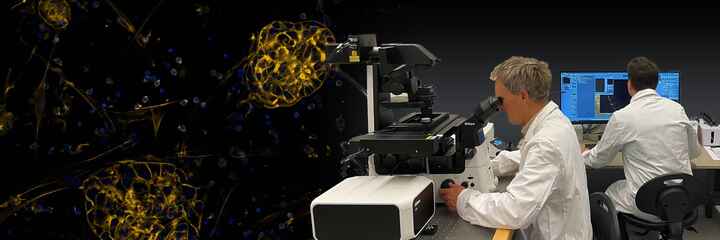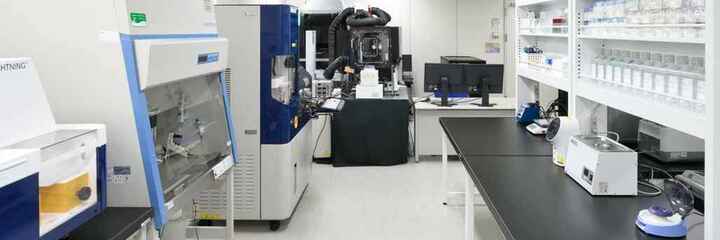Notizie
Nikon Delivers True Spectral Imaging With DIGITAL ECLIPSE C1si
dic 6, 2004
Opening A New World of Spectral Imaging for Cell Biologists
Nikon Instruments today announced an exciting new Spectral Imaging technology combining the strength of conventional imaging with that of spectroscopy to accomplish tasks that separately each can not perform. The new DIGITAL ECLIPSE C1si, a confocal laser fluorescence microscope system, can simultaneously acquire the fluorescence spectrum over a 320nm wide range in wavelength at 10nm spectral resolution or over smaller ranges at 5nm or 2.5nm spectral resolution.
When observed with a light microscope, fluorescent proteins are widely viewed as reporters of transcription in live cells. Most commercial confocal microscopes currently have the ability to collect two or three pre-specified colors simultaneously. However, there is often a need for more complete spectral information to allow the detection of more fluorophores and to facilitate the detection of a specific fluorophore. Background fluorescence from endogenous fluorophores or from interfering exogenous fluorophores can severely reduce detection or interpretation of the image signal. With multiple labeled samples, the signal from one fluorophore is often much stronger than
another and can spill over to an adjacent channel.
It can be very difficult to cleanly separate the signal from multiple fluorescent probes with conventional confocal microscopes because of the overlap of their fluorescence emission spectra. Artifacts due to spillover can be especially troublesome in FRET microscopy where precise localization of the source of the signal is required.
The DIGITAL ECLIPSE C1si solves these problems by acquiring the fluorescence spectrum at a high resolution, mathematically separating the
signals from each probe, and assigning it to a discrete data channel free from confounding spillover. The result is a "stack" of images of the same object or scene, each at a different spectral narrow band or color.
Spectral imaging is usually nondestructive which means it is easy to acquire the spectral characteristics of complex biological materials including living or prepared cells or tissue. This flexibility cannot be realized with conventional imaging systems or with earlier generation confocal microscopes.
"The use of multiple fluorescent labels has long been commonplace in the study of fixed specimens, and is now becoming established for in vivo studies," said Stan Schwartz, marketing vice president, Nikon Instruments, "The DIGITAL ECLIPSE C1si eliminates expensive and cumbersome custom filter sets and provides a time efficient, and cost effective, approach for acquiring optimum wavelength coverage."
Unmatched Versatility
The emission path of the DIGITAL ECLIPSE C1si spectral confocal microscope system, can be easily switched between a standard three channel the fluorescence detector and the high resolution spectral detector, allowing a single instrument to be used for the widest possible range of applications.
Focusing On Brightness
The optical design and signal processing capabilities of the DIGITAL ECLIPSE C1si places it among the most efficient spectral detectors available. Nikon's newly developed Diffraction Efficiency Enhancement System (DEES) and high efficiency fluorescence transmission technology both optimize the signal reaching the photomultiplier tubes. The newly developed Dual Integration Signal Processing (DISP) technology eliminates digitization down time. Together, these technologies ensure the highest efficiency spectral imaging with the best signal to noise ratio.
With DIGITAL ECLIPSE C1si, acquisition of accurate fluorescence spectra in true fluorescence colors is now possible at a spectral resolution as high as 2.5nm. This is possible because wavelength resolution does not depend on confocal pinhole size. The DIGITAL ECLIPSE C1si spectral detector also employs a unique mechanism to prevent illuminating wavelengths from blinding the detector. Sensitivity calibration among fluorescence detectors is performed using a NIST-traceable illumination source verifying the response of each detector element.
Wide Band, High Resolution Spectral Imaging
The high sensitivity and excellent signal to noise characteristics of the DIGITAL ECLIPSE C1si makes possible the high data acquisition rates necessary for live cell spectral imaging. Simultaneous 32 channel spectral image acquisition over a range of 320nm at 10nm spectral resolution is possible using either single or multiple laser excitation. Simultaneous 32 channel acquisition at 5nm or 2.5nm resolution is possible at the same speed at correspondingly reduced spectral range.
Outstanding Imaging of Unmixed Fluorescent Probes without Crosstalk
The power of DIGITAL ECLIPSE C1si is that it can cleanly separate the signals of fluorescent proteins including CFP, GFP, YFP, DsRed, even in combination with closely overlapping antibody conjugates such as Alexa488, Cy3, and others. Clean separation of the signals of probes from autofluorescence is also possible. Not so long ago only three fluorophores were in widespread use (fluorescein, rhodamine and DAPI), but now there is a plethora of fluorophores available, each with its own unique spectral characteristics. This has generated a considerable problem for fluorescence microscopists because many different filter sets are required for double or triple labeled samples. Filter sets use expensive interference filters and dichroic mirrors, and are often difficult to interchange. Collecting the entire spectrum allows the fluorophore to be identified and separated computationally for easy analysis.



